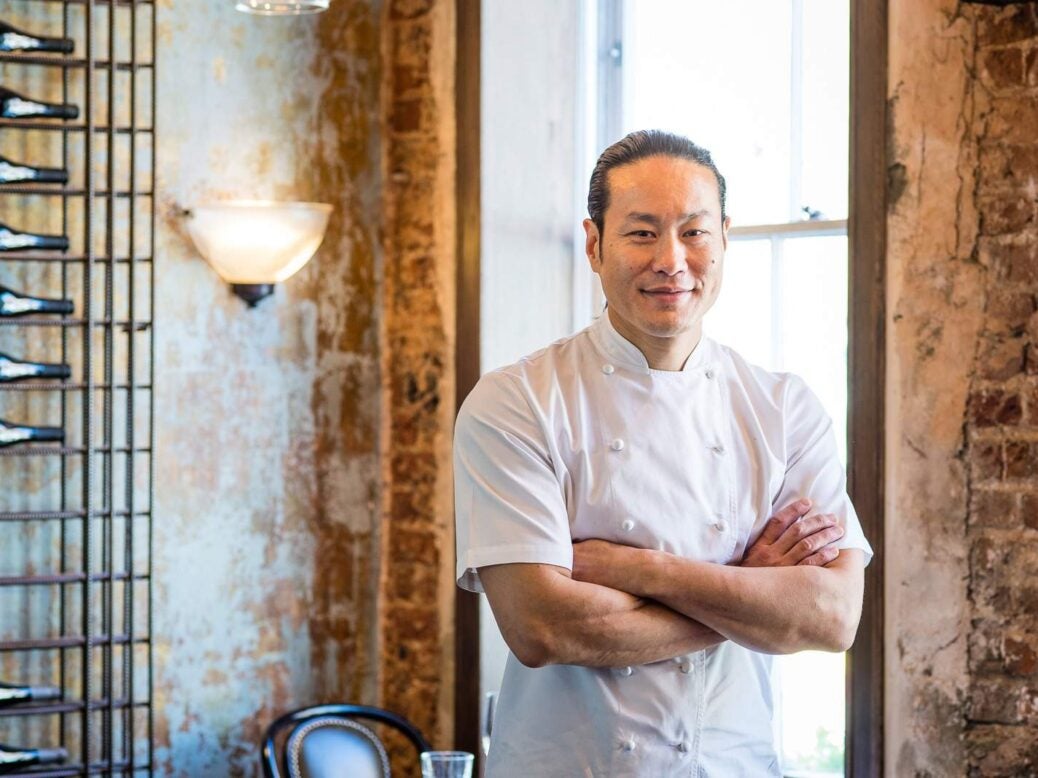
The Japanese-British chef’s food possesses a higher power, writes Rasika Sittamparam
If you feel like the world around you is crumbling, one of the first places I’d suggest for shelter is British-Japanese chef Jun Tanaka’s temple of flavours in Fitzrovia. Exaggeration is part of the game of reviews, but in the case of my visit to The Ninth – it is less so and more of an ode to appreciate Tanaka’s unconscious effort to cure my homesickness, after spending a month with my family in Malaysia.
My reverie of Pina Colada and the never-ending summer of my home country is brought to a halt by a range of French-Mediterranean smells wafting through the bare-brick walls of the Charlotte Street venue. It is the ninth restaurant Tanaka has been involved with, in his culinary-god-laden career alongside the likes of Michel Roux Jr., Marco Pierre White and Eric Chavot. I feel instantly at ease and start looking forward to my journey through his Michelin-quality food. My French dining partner is more naturally sceptical. ‘Michelin stars are overrated anyway,’ he huffs, sipping an aperitif reminiscent of an Old Fashioned which looks adequately pleasing, from his expression.
The appetisers arrive, each with a name more delightful than the other: crispy pork belly, sourdough with Bordier butter, Carlingford oyster with elderflower and perilla, and barbajuans. The soft and salty goodness of the pork belly is devoured first, cleanly cut by the tasty acidity of the accompanying sauerkraut. The fine butter from Bordier is next on the platter, which the Frenchman encouragingly nudges towards me. The butter is as light as it is creamy, and spreads effortlessly over the superior quality sourdough. The oysters stand next in line, covered in the most delightful and flowery type of granita. ‘It’s good isn’t it,’ the waiter beams from across the bar next to our table. I nod, and turn towards the final plate of barbajuans. These are delicate pasties filled with cheese and vegetable, powdered with flour on top to mop up microbeads of oil, in case any were left. There are none on top, thankfully, but there is enough grease within the pastry to create a ‘thud’ sound rather than a harsh ‘crunch’ when I halve one with my spoon. The pastry melts in my mouth, revealing an extremely savoury potato-like mash. ‘Delicious,’ I exclaim, as though my meal was nearing a finale.
In pure French-Mediterranean manner, the end still seems a hundred nautical miles away. A plate of raw mackerel arrives, with the skin flambéed to give it a barbeque-y scent. The freshness of the fish pairs well with the olive oil drizzle on top, with dill, cucumber bits and capers joining the beach party. The simple dish is a culinary feat, judging by the way I mop up every fleck of flavour in sight.
But the deeper I dive into the culinary experience Tanaka has designed for his guests, the more surprised I become at the depths of my appetite. A richly purple and white dish of beetroot, pear, burrata and hazelnuts looks inviting. ‘Oh Jesus,’ my dining partner exalts, while I close my eyes and enjoy the ridiculously creamy, nutty and sweet flavours in play. Hare and foie gras agnolotti arrives next with a very rich consommé, leaving me in a trance-like state. I take a break and politely refuse yet another plate of pasta, this time it’s orecchiette with fresh truffle slices and a glistening yolk. The Frenchman attacks it instead, to my relief.
There are two stars of the night. The first is a devilishly good roast venison, served with a dark and savoury jus, chestnutty puree and glazed apricot halves. A bite into the succulent dish transports me away from my initial thoughts of lounging on a tropical beach, and another one makes me forget I’ve even been away, anywhere. I am living in the present with the meat cooked so well it could be at the banquet of a tsar. Or the Malaysian king, who, I have heard, is a fan of the finest things in life.
The final star boasts the most dazzling glaze of all the dishes of the night: a pain perdu served to look as golden as it could – drenched in a syrup so good that it was incomprehensible. The dessert’s surface produced the tiniest of ‘crack’ when tapped with a spoon, the way you would hear on the surface of a crème brulee. The inside of the pain perdu is soft and creamy, almost to the extent of a brulee, cleverly hiding the fact that it was once some sort of bread. Every inch of this quickly disappears, magicked into our mouths.
My soul is healed, my head is cleared, and my appetite for Tanaka’s cooking has reached a height I never fathomed to be possible before. The Frenchman shares my sentiment and finally approves of the restaurant’s Michelin-starred calibre he was previously sceptical about.
Rasika Sittamparam is senior researcher at Spear’s











